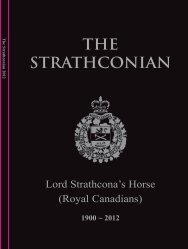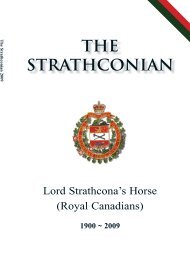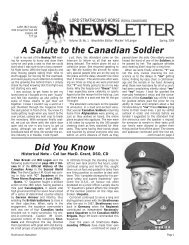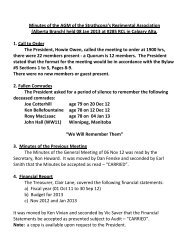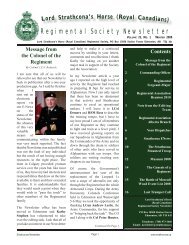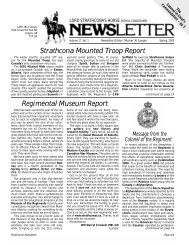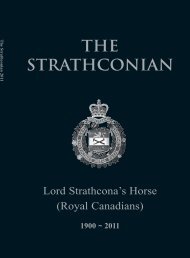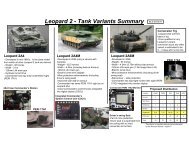Regimental Society Newsletter S s - Lord Strathcona's Horse
Regimental Society Newsletter S s - Lord Strathcona's Horse
Regimental Society Newsletter S s - Lord Strathcona's Horse
You also want an ePaper? Increase the reach of your titles
YUMPU automatically turns print PDFs into web optimized ePapers that Google loves.
<strong>Regimental</strong> Connections: The Never Ending StoryBy John BoileauAfter retiring in 1999 and settling in Nova Scotia—far from the Regiment’s traditional stomping grounds—I did notexpect there would be many occasions when I would make Strathcona connections. In fact, just the opposite hashappened. I thought I would share a few of these from 2008 with fellow Strathcona’s, especially since the Colonelof the Regiment, John Roderick, has exhorted the “old and bold” to make more contributions to the <strong>Newsletter</strong>John Doble (right), the last 17th/21stLancers exchange offi cer in Germanystands beside Patrick Harvey (left),Brig Fred Harvey’s great nephew,at the Moreuil Wood memorial to theCanadian Cavalry Brigade.When the Regiment was stationed in Iserlohn 1965-1970, our last 17th/21st Lancers’exchange officer there was John Doble, in many ways the epitome of an eccentricBrit. John, a single officer at the time, was the 2IC of C Squadron, where I was firsta troop leader and then Sqn LO. When he asked my future wife—a nursing sister inQueen Alexandria’s Royal Army Nursing Corps at British Military Hospital Iserlohnat the time—what he could do about the dirt on his sweater, Miriam told him to washit. Clearly astonished, he asked, “You mean you can wash these?”After his exchange tour, John left the British Army and joined the Foreign Service. Heworked as a diplomat in many places, especially sub-Saharan Africa, including SouthAfrica and Mozambique, before finishing his career as the British High Commissionerto Swaziland. John and I have maintained contact over the years, a connection thatwas reinforced during my time as CO in Calgary when John was the British Consul-General in Edmonton, responsible for most of Western and Northern Canada. He hassince visited us twice in Nova Scotia.On March 29-30, 2008, John visited Moreuil Wood as part of a battlefield tourconducted by Brough Scott, an old Oxford chum of his. Brough is the grandson ofBrigadier Jack Seely, who commanded the Canadian Cavalry Brigade at MoreuilWood. In 2003, Brough wrote a biography of Seely, entitled Galloper Jack: AGrandson’s Search for a Forgotten Hero. I highly recommend this book to all Strathcona’s; it is a well-written studyof a fascinating character.The tour traced the 120-mile route of the Canadian Cavalry Brigade from its camp at Ennemain to Moreuil. Itincluded Brig Fred Harvey’s great nephew, Patrick Harvey, a Church of Ireland clergyman, who presided overprayers in the thick of Moreuil Wood in the pouring rain. The previous week, Britain’s Sunday Telegraph hadpublished Brough’s account of the battle, which focussed on Seely’s horse, Warrior (on the actual 90th anniversaryof the battle, the Halifax Chronicle Herald published my story about the battle).Although Brough is very passionate about his grandfather, he is perhaps even more passionate about horses. Aftercollege, he was a professional jockey (with about 150 winners), and a horseracing commentator for TV. He is nowa sports writer. Brough supported a campaign to have Seely’s charger, Warrior, presented with the Dickin Medal,which is often referred to as the “animals’ Victoria Cross” and is awarded by the PDSA, Britain’s leading veterinarycharity.On October 6, I received a phone call out of the blue from Britain from a lady at the PDSA who was trying to gatherdocumentary support for such a nomination on very short notice. As Seely’s grandson, Brough was reluctant to beone of the signatories. John Doble would have been a natural, but he was out of touch on one his many treks intothe Himalayas. Brough had suggested the society contact me to provide a nomination for Warrior, confirming hewas at the Battle of Moreuil Wood and that he deserved the medal.I was delighted to provide such a nomination and quickly sent off the following by email:“As a former Commanding Officer of <strong>Lord</strong> Strathcona’s <strong>Horse</strong> (Royal Canadians), a Canadian cavalry regiment thatwas part of the Canadian Cavalry Brigade commanded by Brigadier-General Jack Seely during the First WorldContinued On Page 8Strathconas <strong>Newsletter</strong>Page 7www.strathconas.ca



